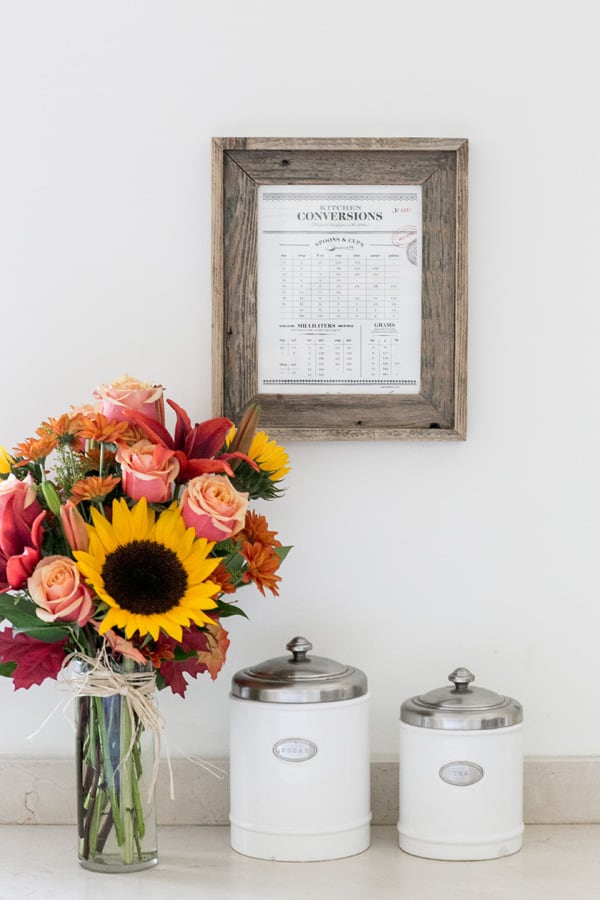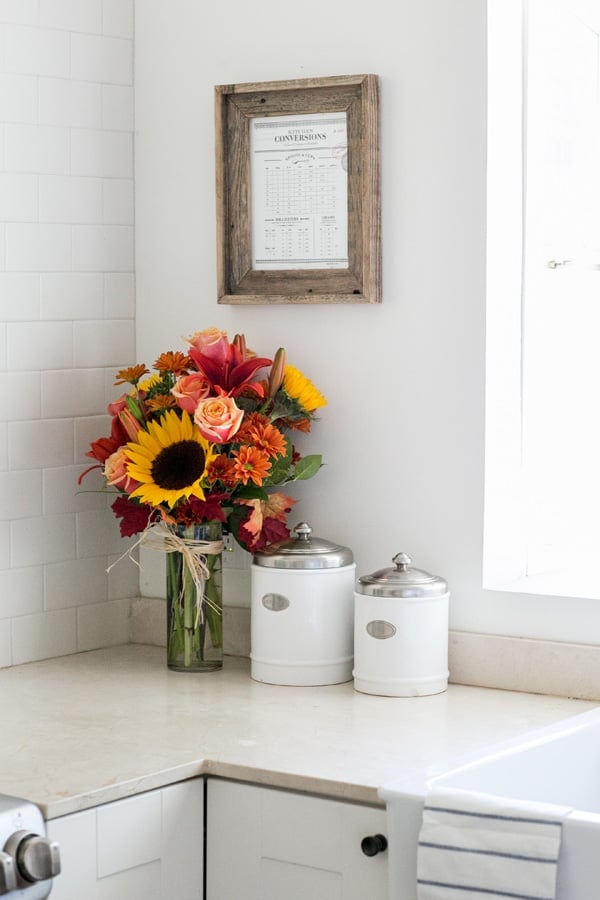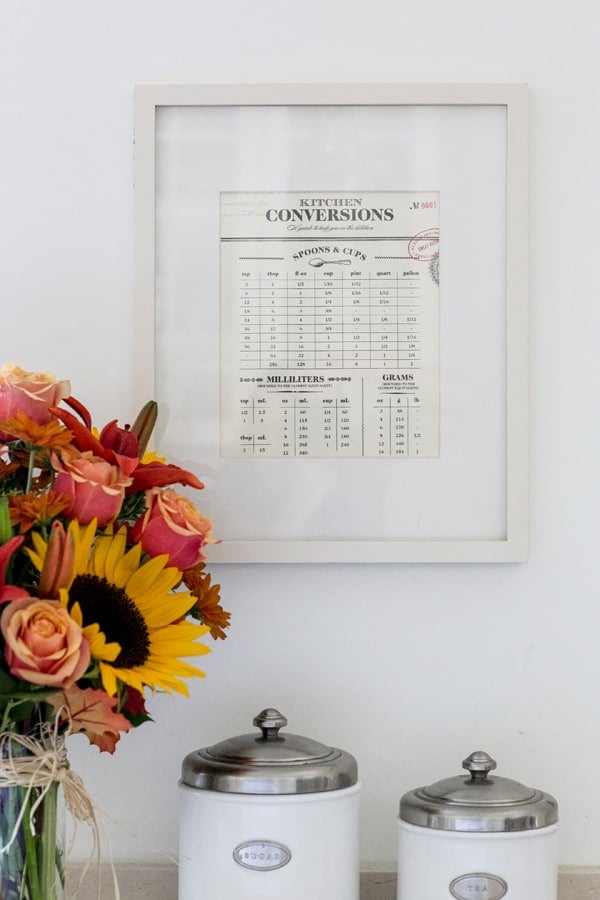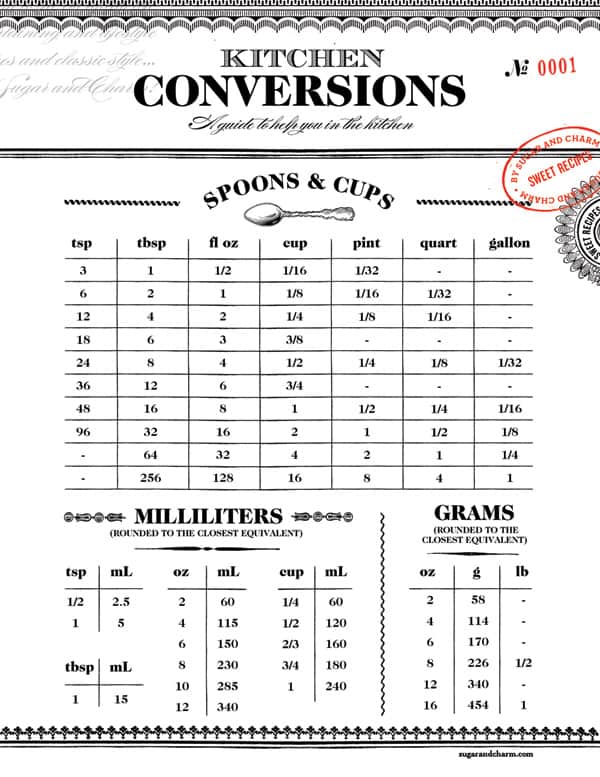With the baking season upon us, I thought it would be helpful to have a charming “cheat sheet” or kitchen conversion chart for convenience! We’re answering common questions like how many cups in a pint? How many quarts in a gallon? And How many cups in a quart?
We’re pleased to share our charming printable kitchen conversion chart with you all as well as a complete guide for cooking and baking.
Cooking and baking can be a lot of fun. In fact, studies show that cooking can boost your self-esteem and quality of life.
However, when you’re dealing with a complicated recipe with a bunch of exact measurements, cooking can sometimes feel like a math equation.
This is especially the case if you don’t have the right measuring devices and need to do conversions.
If you’re someone who struggles with measuring conversions, don’t worry. They can be tricky to get the hang of, and that’s why we’ve created this guide.
Read on to discover the top measuring conversions you need to know for cooking and baking and to print our kitchen conversion chart for quick baking and cooking conversions.
We use it for quick answers to things like how many quarts in a cup? or how many quarts in a gallon?

Basic Cooking and Baking Conversions
Let’s begin by going over some basic nuts and bolts conversions that you’ll need to know when cooking and baking.
Dry Measurement Conversions
3 teaspoons (tsp) = 1 tablespoon (tbsp) = 1/16 cup
6 tsp = 2 tbsp = ⅛ cup
12 tsp = 4 tbsp = ¼ cup
24 tsp = 8 tbsp = ½ cup
36 tsp = 12 tbsp = ¾ cup
48 tsp = 16 tbsp = 1 cup
Pinch or a dash= Less than 1/8 teaspoon
5 tbsp + 1 tsp= 1/3 cup
When measuring out dry ingredients, you should always use a cup for larger quantities and a spoon for smaller quantities. Use a knife or a spatula to level your ingredients, and remember that you should pack moist ingredients like brown sugar.
Liquid Measurement Conversions
8 fluid ounces (fl oz) = 1 cup (C) = ½ pint (pt) = ¼ quart (qt)
16 fl oz = 2 C = 1 pt = ½ qt
32 fl oz = 4 C = 2 pt = 1 qt = ¼ gallon
128 fl oz = 16 C = 8 pt = 4 qt = 1 gallon
When measuring out liquid ingredients, you should always use liquid measuring cups. Always place the cup on a surface, and then position yourself so that your eyes are level with the graduated markings on the cup. For smaller liquid quantities, use measuring spoons.
Volume vs Weight Ounces
When cooking and baking, it’s important to remember that volume ounces are not the same as weight ounces.
Liquid and other ingredients are measured in volume ounces, while dry ingredients are measured in weight ounces.
On packaged goods, weight ounces are listed as “NET WT OZ”, where the WT stands for weight. Liquid ounces are measured as “NET OZ FL”, where the FL stands for fluid.
To convert between liquid and weight measurements, you’ll need to know the density of the ingredient, which is why this isn’t done often.
Imperial vs Metric
The United States uses the Imperial System for measurement, whereas the rest of the world uses the Metric System. So, if you’re following a recipe from outside of the US and the ingredients are listed using the metric system, you’ll need to know how to convert it to the Imperial System
Here are some common conversions you need to know:
Metric to Standard (Imperial) for Volume
1 milliliter= 1/5 teaspoon
5 milliters= 1 teaspoon
15 milliliters = 1 tablespoon
240 milliliters = 1 cup (or 8 fl oz)
500 milliliters= 2 cups= 1 pint
1 liter = 4 cups = 2 pints = 1 quart (34 fl oz)
Metric to Standard for Weight
1 gram = .035 ounces
100 grams= 3.5 ounces
454 grams = 1 pound
500 grams = 1.1 pound
1 kilogram = 2.2 pounds = 35 ounces
What Does 1 Cup Equal?
Even if you’re short on kitchen cooking materials, you likely have a 1 cup measurement. And with just this, you can get pretty far in your cooking and baking.
Plus, this can be extremely useful when you’re making conversions to half or double a recipe. Here’s what 1 cup is equal to:
- 8 fluid ounces
- 16 tablespoons
- 48 teaspoons
- 1/2 pint
- 1/4 quart
- 1/16 gallon
- 240 ml
Baking Pan Conversions
Sometimes, you come across a delicious-looking cake recipe that calls for a certain type of baking pan.
If you don’t have the exact type, or you just prefer to make a different style of cake, don’t worry. By knowing how much cake batter goes into each type of pan, you can easily modify your recipe.
Here are the conversions you need to know:
9-inch round cake pan= 12 cups of batter
9×5 loaf pan = 8 cups of batter
9-inch square pan= 8 cups of batter
9-inch springform pan = 10 cups
10-inch tube pan= 16 cups
10-inch bundt cake pan= 12 cups
Common Baking Measurements in Ounces
Remember how we talked about that liquid ounces aren’t the same as weight ounces? In other words, 8 oz of weight is very different than 8 fl oz. And while 8 fl oz is close to 1 cup, 8 oz of dry ingredient rarely equals one cup.
Here are some common baking conversions to keep in mind:
- 1 cup of rolled oats= 3 ounces
- 1 cup milk = 8 oz
- 1 cup vegetable oil = 7.7 oz
- 1 cup butter = 8 oz
- 1 large egg = 1.7 oz
- 1 cup all-purpose flour = 4.5 oz
- 1 cup granulated sugar = 7.1 oz
- 1 cup unsifted powdered sugar = 4.4 oz
- 1 cup unsifted powdered sugar = 4.4 oz
- 1 cup heavy cream = 8.4 oz
- 1 cup chocolate chips = 6 ounces
- 1 cup peanut butter = 9.5 ounces
- 1 cup sour cream = 8 ounces
- 1 cup coconut, sweetened flakes = 3 ounces
Egg Conversions
A lot of recipes call for eggs, which is why it’s very important to understand the different types of egg conversions.
Typically, when a recipe calls for eggs, it’s calling for whole, extra-large eggs. However, you may have only medium or small eggs in your fridge
Here are the conversions you need to know for eggs:
- 1 eggs= 1 medium or 2 small eggs
- 2 eggs= 2 medium or 3 small eggs
- 3 eggs= 4 medium or 4 small eggs
- 4 eggs= 5 medium or 6 small eggs
- 5 eggs= 6 medium or 7 small eggs
In addition to egg size, sometimes recipes call for liquid eggs instead of whole eggs. Here are the conversions you need to know for that:
- 50 mL liquid whole eggs= l large egg
- 100 mL liquid egg whites= 3 egg whites
For a simple substitution, just remember that one whole egg is equal to two egg whites, or 1/4 cup of egg substitute.
Frequently Asked Questions
There are 4 quarts in a gallon.
There are 4 cups in a quart.
There are 2 cups in a pint.
Measuring Out Common Baking Ingredients
The key to excelling at baking is to measure things out in perfect portions. Even an ounce off here or there can seriously screw up an entire recipe. Here are some things to keep in mind when measuring with common baking ingredients:
Flour
Flour is arguably the most important ingredient to measure accurately. Unfortunately, flour can be very difficult to measure by volume (in measuring cups). For this reason, it’s a good idea to invest in a kitchen scale so you can measure your flour by weight.
However, if you don’t have a kitchen scale, here’s what you need to remember about measuring flour:
- Avoid scooping the flour out with the measuring cup, as this can cause the measurement to be way denser than it needs to be
- Instead, fluff up your container of flour and scoop it out with a spoon
- Spoon it into your measuring cup and scrape the excess off the edge
- If possible, use a flour scoop to scoop your flour
Butter
There are so many different measurements used for butter, and it can all get very confusing.
However, here’s really all you need to keep in mind:
1 stick of butter = 8 tablespoons = 1/2 cup = 4 ounces = 113 grams
Sugar
Luckily, measuring out sugar is much simpler than measuring out butter or flour.
Here are the conversions you need to know:
Granulated White Sugar
1 cup = 7.05 ounces = 199 grams
Brown Sugar
Pay attention to the instructions on the recipe, as it will usually say brown sugar “lightly packed” or “densely packed”.
1 cup packed light or dark brown sugar = 7.05 ounces = 200 grams
Powdered Sugar
If you’ve baked with powdered sugar before, then you know what a mess it makes when trying to measure it out.
The easiest and most accurate way to measure with powdered sugar (also known as confectioner’s sugar) without making a mess is to spoon the sugar into your measuring cup. Then, scrape the excess off from the sides.
Also, make sure you understand the order of sifting with powdered sugar:
- 1 cup sifted powdered sugar = sift the sugar before measuring
- 1 cup powdered sugar, sifted = Wait to sift until after measuring
Then, here are the conversions you need to keep in mind with powdered sugar:
1 cup powdered sugar, sifted = 3.6 ounces = 102 grams
1 cup powdered sugar, unsifted = 4.4 ounces = 125 grams
Baking Soda
Before measuring out baking soda or baking powder, you should slightly shake up the container to help eliminate any chunks. Then, use a measuring spoon to gently scoop it out and use a flat edge to scrape the excess off the top.
Also, make sure the baking soda you’re working with is fresh. Anything older than 6 months should be tossed out.
Liquid Sweeteners
If the recipe calls for both liquid sweetener and oil, measure out the oil first, as this will help grease the measuring cup.
You can also spray nonstick spray inside the measuring cup. Here are the liquid sweetener conversions you need to know:
- Honey: 1 cup = 8 ounces = 227 grams
- Molasses:1 cup = 12 ounces = 340 grams
- Maple/corn syrup: 1 cup = 11 ounces = 311 grams
Baking Time Conversions
Last but not least, let’s talk about baking time conversions, as you may be working with a recipe that uses Celsius when you operate in Fahrenheit. Here are common temperature conversions to keep in mind:
- 120 Celsius= 250 Fahrenheit
- 160 Celsius= 320 Fahrenheit
- 180 Celsius= 350 Fahrenheit
- 205 Celsius= 400 Fahrenheit
- 220 Celsius= 425 Fahrenheit
Measuring Conversions: Wrap Up
As you can see, there are a lot of measuring conversions to keep in mind. Luckily, whenever you forget something, you can just refer back to this guide for help.

The Kitchen Conversion Chart – So Useful!
You can print it, frame it, place it in a drawer or on the fridge… wherever you’ll need it.It makes a lovely piece of art when framed and looks charming in a kitchen. I hope you all enjoy it as much as I do!
You can also tape the charming printable kitchen conversion chart inside a pantry door or hang it in a pantry.
I honestly use this chart so often and it’s nice to quickly glance instead of searching for it on my phone!
It has saved me so much time when baking.
We hope this charming printable kitchen conversion chart becomes a little kitchen helper for you!
Framed Kitchen Conversion Chart – A Great Gift For The Baker In Your Life!
This chart makes a great gift for anyone who loves to bake. Frame it or laminate it for a friend who can use it in their own home.
A frame really elevates this kitchen conversion chart into a really lovely gift.
When it comes to frame what do you choose? Ornate, lacquered wood? Or a sleek, contemporary surface? The style of your frame can make just as much of a statement as the artwork itself. If you know the recipients kitchen then that can guide your choice nicely.
If you’re unsure, I recommend choosing a no-fuss flat frame in either black or white. This allows the artwork to shine and allows for a clean and modern aesthetic.

Printing Your Kitchen Conversion Chart
Download two sizes below to print or fit a frame. Print at home or for best quality, bring the file to an office supply store to print on card stock.
I recommend printing a few so when you come home and frame it you have extras for edge trimming, etc.
Let us know if you have any questions about downloading and printing. We are more than happy to help.
Click on the size to download the file 8×10 and 5×7
More Free Printables you’ll Love!
Mix n Match Cocktail Printable
If you have any questions about these measuring conversions, comment below.
We hope we were able to answer your measuring and conversion questions like How Many Quarts in a Gallon? How Many Cups in a Quart? And How Many Cups in a Pint?
If you have any questions about these measuring conversions, comment below.
You can also FOLLOW US on FACEBOOK, INSTAGRAM, and PINTEREST to see more delicious recipes, cocktails, desserts, and parties!



I have had a copy of this chart hanging on my fridge for years now – I don’t even know how long really. It has gotten crumpled by toddlers, splattered, and spilled on, but I have referred to it many times while cooking and also while helping my kids with their math assignments (we homeschool!). I decided it was time for a fresh copy and was happy to find you still have it up! I printed it out again and laminated it this time, so it will be on my fridge for many more years. Thanks so much!
Hello, is there a mistake in the oz and gram table for the USA? 2 oz has to be 56 grams, right? and are there errors in other oz and grams?
Hi Eden, I am a student from Glasgow studying nutrition and dietetics. A group of students on the course are working on a sustainable student cookbook and looking for a conversion chart to include in the reference section. Would we be able to use your chart please with attribution to yourself and a link to this website for further information.
Many thanks
Hi Elaine – Thanks for reaching out. With proper credit in the handbook, you may use it 🙂 Thanks!
Hi Eden, that is fantastic thank you! We will definitely credit it back to you with links. Best wishes 🙂
Oh, Eden! Thanks, buddy, for sharing such a useful chart. Since when my measuring spoon is broken, I couldn’t add spices and herbs with the right proportions, and every time, I feel like I am dumb. But, now, every mishap would become a story because of this chart that I have got printed. I hope with the help of this chart; my cooked meals will get back their taste.
Just what we need in the kitchen. Thank you very much for sharing!
Great vintage design too. You are so talented!
Wow! Thank you so much for the printable Conversion Chart. I have a food blog that focuses on blended diets and my viewers are from all over the world. My problem has been writing recipes for everyone when I am in the USA where we still use the Imperial measurements. Your chart will help those reading my blog convert the recipes to metric. I will post the link to your website.
Thank you! No need for me to make one. 🙂
This is so cute! I’ve been looking for a cute kitchen conversion sheet for my kitchen! This is the cutest!
This is a beautiful website! You’ve done excellent with it. I’ve enjoyed looking through your materials and posts. 🙂
Hi, I’m getting an 404 file not found page, can you re-up the link/file please?
Hi! Thank you for letting me know… we just switched to our brand new site today, so things are still a little wacky! We will get this fixed asap!!
Hi, can you tell me where you purchased the frame?
Love this! Thank you! 🙂
Just printed it! Awesome! Thank you! 😉
Just beautiful; thank you!
eden! thank you, this is so lovely. i printed it on cardstock and i love it! so handy 🙂
love it!!
I love this!!
This is perfect! I love that you made this into kitchen art!
Thanks for sharing! This is perfect!